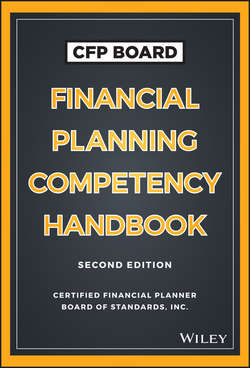Читать книгу CFP Board Financial Planning Competency Handbook - Board CFP - Страница 9
На сайте Литреса книга снята с продажи.
PART One
Introduction
ОглавлениеCharles R. Chaffin, EdD
CFP Board
Part One outlines much of the theoretical content of financial planning, exploring what the practitioner needs to know in order to effectively serve the client. Each of the chapters focuses on one specific topic area of financial planning, allowing the reader to use this book as a reference either throughout a given program of study or throughout practice.
The connections diagram at the beginning of Part One chapters provides a visual representation of how a particular topic relates to the content areas in financial planning. A short paragraph below each of the diagrams provides a general analysis of many of the main connections relative to a given topic. For example, a given topic may have specific connections to three or four content areas across the discipline of financial planning.
Students and faculty are encouraged to use these diagrams to facilitate dialogue in the classroom or online learning platform regarding how the particular subject area impacts others across the curriculum. Faculty may consider going around the different illuminated topic areas, discussing specific instances or circumstances where these content areas are related. Faculty teaching within a financial planning program may find it beneficial to review many of these diagrams with the objective of making explicit connections across the curriculum. Whether students are new to financial planning or have years of experience, providing key examples of how content areas are interrelated can help further the student's understanding of key concepts within financial planning practice. With regard to practice, given the diversity of positions within financial planning, practitioners are encouraged to use this connections diagram as a reminder of the interrelatedness of financial planning content areas.
The opening of each chapter provides an overview of the topic as well as historical background of the topic. This overview is meant to provide a basis for how this topic sits within personal financial planning. The content in this area is not meant to replace the specifics that come from a standard textbook. Rather, it is designed to provide a framework for the topic relative to financial planning practice.
Each of the chapters in Part One of this book contains a section devoted to student-centered learning objectives. These objectives are designed to outline what the student should be able to do relative to the particular chapter topic. Practitioners are encouraged to examine each of these outcomes to determine their own effectiveness relative to the topic area. Whether working in the field of personal financial planning or a related discipline, practitioners can benefit from a better understanding of their own effectiveness relative to these important concepts in personal financial planning. It may be that if the practitioner self-identifies areas of specific weakness in these objectives, he or she may decide to enroll in a continuing education program that can assist in improving efficacy relative to this topic.
The In Class sections of Chapters 2 through 70 note the learning experiences and assessment possibilities for facilitating higher-order cognitive thinking in the financial planning classroom. These tables should assist faculty in developing class activities and assessment avenues that further higher-order cognitive thinking in financial planning preparation programs. These charts are designed for all program types and delivery methods.
In this book, the professional practice capabilities are divided into three levels based on this Dreyfus model – entry-level, competent, and expert – each of which illustrates the financial planning professional's ability to make appropriate decisions within a complex environment as well as the planner's progression from strict adherence to rules to use of past experiences to define future action.
The reader is encouraged to use these practice capabilities to both self-assess competency relative to a given concept as well as plan future education and experience that may facilitate a higher level of expertise. Financial planning firms may utilize these capabilities to facilitate formal and informal mentorship programs within their organizations.
Each of the chapters in Part One outlines many of the contexts that exist in financial planning, specifically relative to the topic of that particular chapter. These contexts, or vignettes, are designed to provide the student, practitioner, and instructor with specific situations in which this concept arises in real life as well as to offer some of the variables that may impact the decisions of the financial planner.
Relative to each of these contexts, the reader is encouraged to consider altering some of the fact patterns in the scenarios to see if the actions by the financial planner would change under different circumstances. Students and faculty are encouraged to discuss these scenarios and offer alternative actions that the financial planner could take relative to this or other scenarios and contexts.
Nearly 400 practice questions are available at www.wiley.com/go/wileycfpboard2e. Your access code is at the back of this book. CFP® professionals in the United States can also choose to obtain the full 28 credit hours by taking and passing the test.
